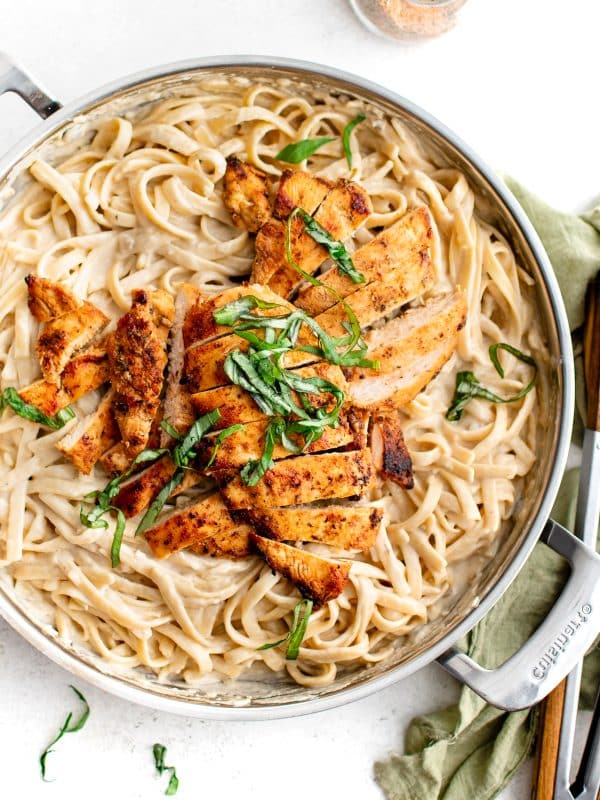This post may contain affiliate links. See my disclosure policy.
Yakitori is a Japanese grilled chicken recipe served on skewers and glazed in a delicious sweet and savory homemade yakitori sauce. Often served with drinks at bars in Japan, enjoy chicken yakitori as a quick and easy appetizer, snack, or dinner.

Yakitori (焼き鳥) is one of the most popular and well-known dishes in Japan. Available in supermarkets, shopping centers, food courts, and food stands, you don’t have to go far to get your fill of these convenient little chicken skewers.
Today I’m sharing how to make Yakitori at home. They’re super easy to make with just a few ingredients and can be cooked on the grill or broiled in the oven.
What is Yakitori?
The term “yakitori” (焼き鳥) is derived from two Japanese words: “yaki,” which means “grilled,” and “tori,” which means “bird” or “chicken.” The dish is typically made from bite-sized pieces of chicken, which are threaded onto bamboo or metal skewers and then grilled over a charcoal fire. Yakitori may include various parts of the chicken, such as breast, thigh, wings, liver, and even skin.
The chicken pieces are often seasoned with either a simple salt or a savory-sweet sauce called “tare,” which is made from soy sauce, mirin, sake, and sugar. Yakitori is a popular street food and izakaya (Japanese pub) staple, often enjoyed with a cold beer or other beverages. Other meats and vegetables can also be prepared in the yakitori style, but the term yakitori usually refers specifically to grilled chicken skewers.
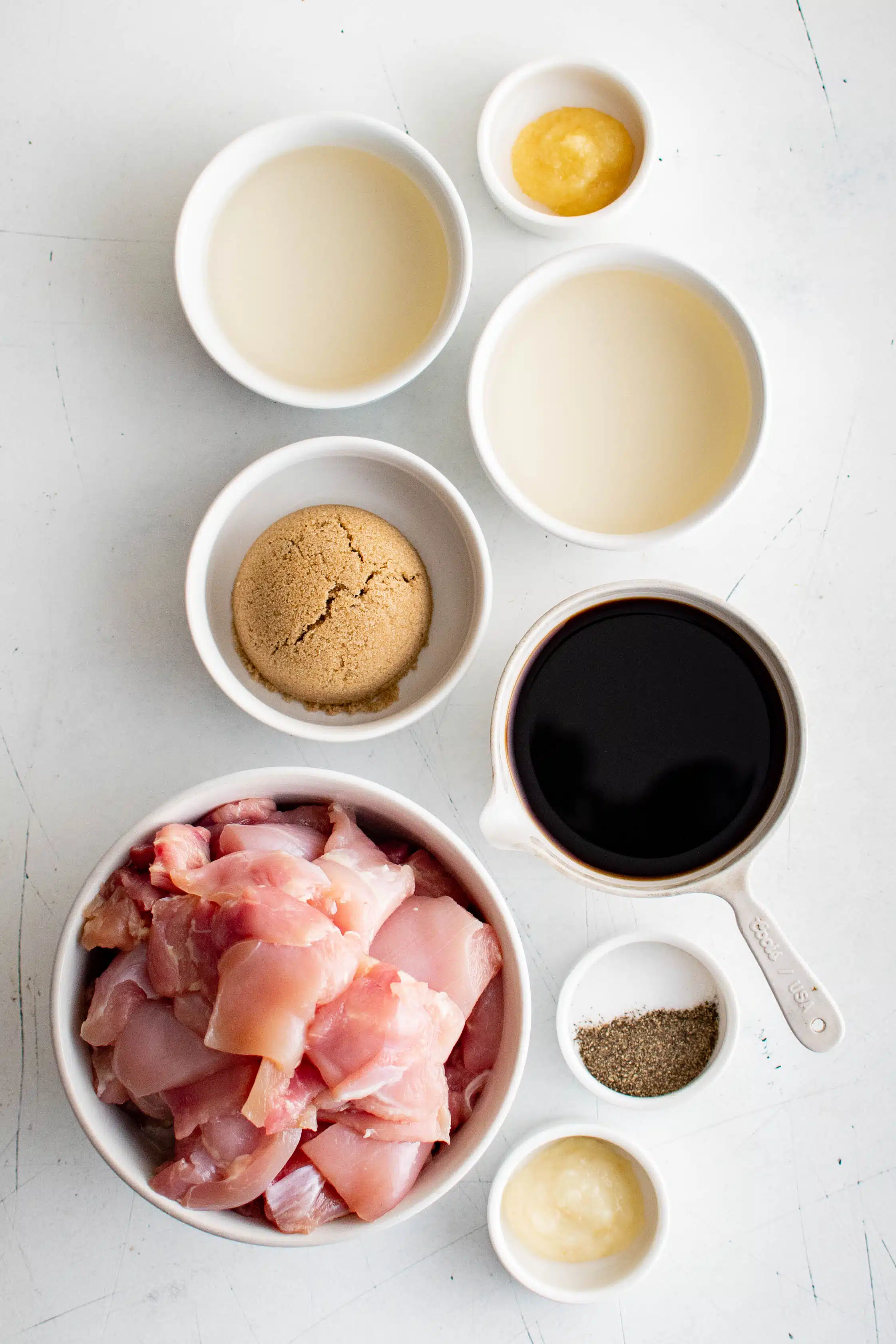
Yakitori Ingredients
- Chicken
- Soy sauce
- Mirin (Japanese rice wine)
- Brown sugar
- Sake
- Salt and black pepper
- Garlic and ginger (optional)
Is Yakitori Sauce the Same as Teriyaki Sauce?
Yakitori sauce and teriyaki sauce are similar in that they are both Japanese sauces with a sweet and savory flavor profile, but they have some differences in terms of ingredients and traditional usage.
Yakitori sauce (“tare”) – Typically used for grilling skewered chicken (yakitori). The sauce is brushed onto the skewered chicken during the grilling process and may also be served as a dipping sauce.
Teriyaki sauce – Used in various Japanese dishes, not just for chicken but also for fish, beef, and other meats. The sauce is used to marinate or glaze the meat, which is then grilled, broiled, or pan-fried.
Yakitori sauce is usually thicker and more concentrated, whereas teriyaki sauce is often lighter and may have a more pronounced sweetness. Despite their differences, they can be used interchangeably in some cases, but the end results may not be exactly the same in terms of flavor and texture.
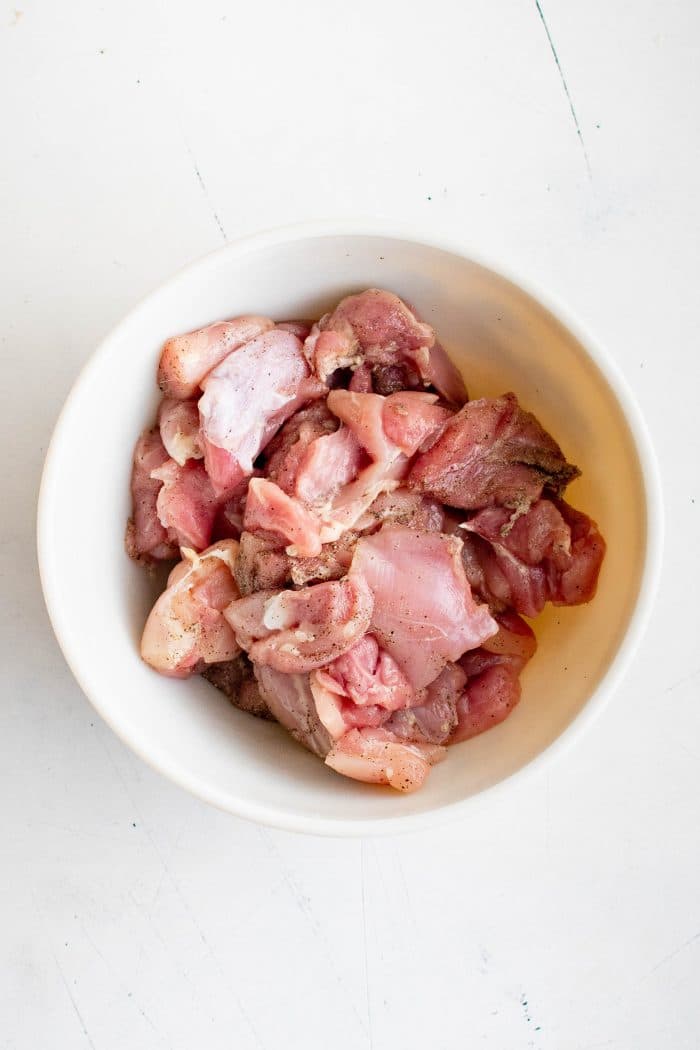
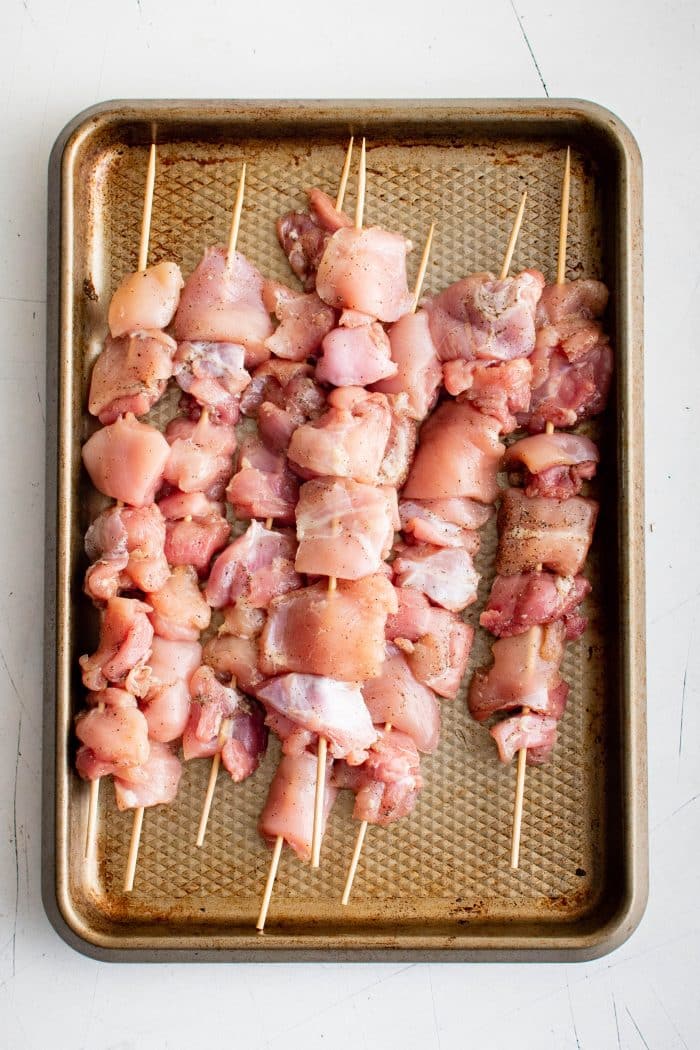

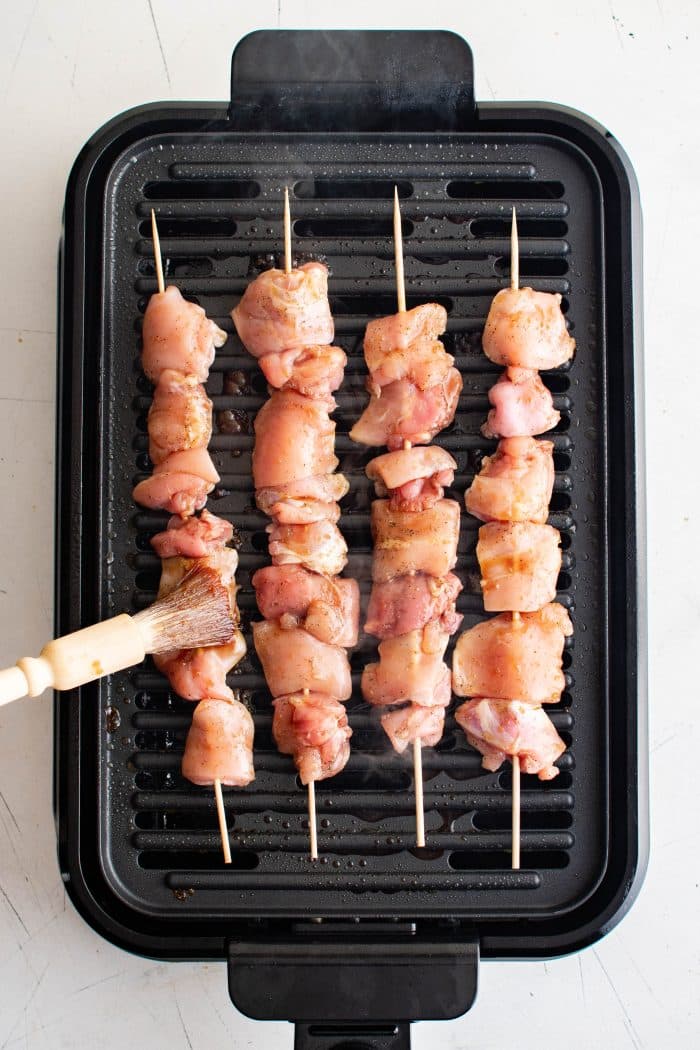
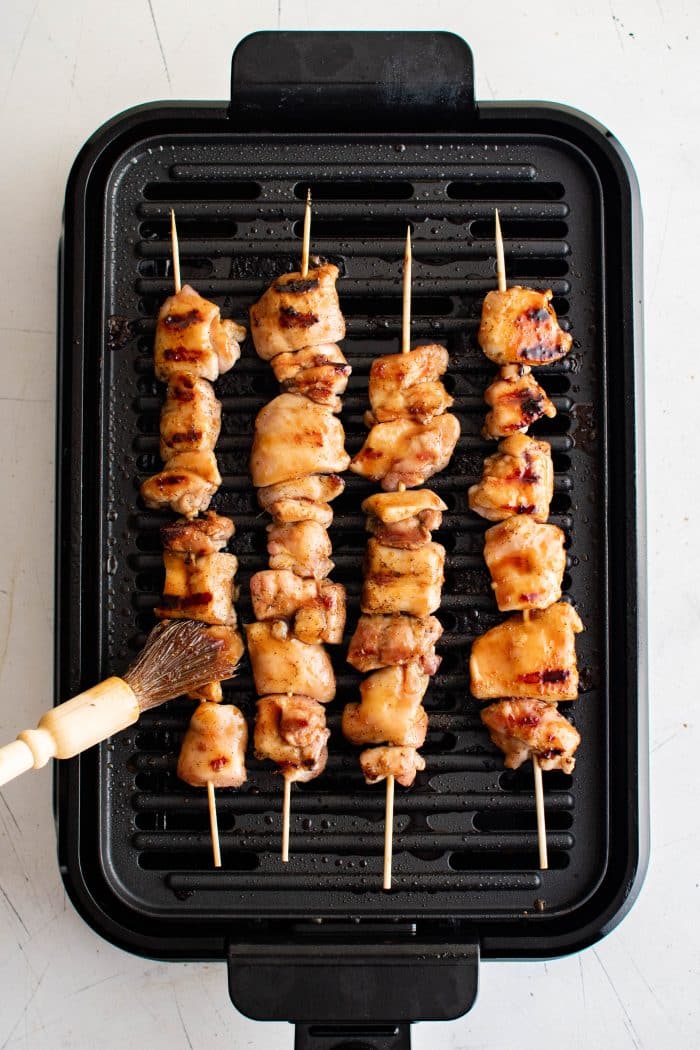
How to Make Yakitori
1. Soak the skewers and prepare the chicken: Begin by soaking your wooden skewers in water for at least 30 minutes prior to cooking. Meanwhile, chop the chicken into small pieces and season with salt and black pepper.
2. Make the yakitori sauce (tare): Add the soy sauce, brown sugar, sake, mirin, ginger, and garlic to a small saucepan set over medium heat. Simmer for 5-6 minutes or until the sauce thickens and is reduced by about a third. Once thickened, set aside half of the sauce for basting and the other half for dipping.
3. Preheat the grill: Lightly oil the grill grates with non-stick cooking spray and preheat the grill to medium-high heat.
4. Thread chicken onto the skewers.
5. Grill and baste: Place the skewers on the grill and cook for 3 minutes before flipping each skewer over. Baste the cooked side with the prepared sauce and continue to cook for an additional 3 minutes. Flip again, every 2 minutes, brushing them each time with the sauce until they are cooked through.
Broiled Chicken Yakitori
1. Soak the skewers and prepare the chicken: Begin by soaking your wooden skewers in water for at least 30 minutes prior to cooking. Meanwhile, chop the chicken into small pieces and season with salt and black pepper. Thread the chicken onto the skewers, leaving some space between each piece for even cooking.
2. Make the yakitori sauce (tare): Add the soy sauce, brown sugar, sake, mirin, ginger, and garlic to a small saucepan set over medium heat. Simmer for 5-6 minutes or until the sauce thickens and is reduced by about a third. Once thickened, set aside half of the sauce for basting and the other half for dipping. Brush the skewers lightly with the sauce.
3. Preheat the broiler: Set your oven to the broil setting and let it preheat for about 5-10 minutes. Position the oven rack about 6 inches below the broiler element.
4. Line a baking sheet: Place aluminum foil on a baking sheet or broiler pan for easy cleanup. Place a wire rack on top of the lined baking sheet, which will help the skewers cook evenly and prevent sticking. Place the prepared skewers on the wire rack, leaving some space between each skewer for even cooking.
5. Broil the yakitori: Place the baking sheet with the skewers in the preheated oven and broil for about 4-5 minutes. Then, carefully flip the skewers using tongs, and broil for another 4-5 minutes on the other side. During the cooking process, you can baste the skewers with more yakitori sauce if desired. Cook until the chicken is cooked through and has a slightly charred appearance.

What to Serve with Yakitori?
Yakitori is a versatile dish that can be served with various side dishes and accompaniments. Some of my personal favorites include:
- Steamed rice: white rice, brown rice, or sticky sushi rice.
- Edamame: boiled and salted soybeans in the pod or stinky breath, extra garlicky.
- Green salad or cucumber salad: with a light sesame ginger dressing.
- Grilled or roasted veggies: you can even try my grilled veggie skewers.
- Cold beer or sake: as an enhancement of the overall dining experience.
Recipe Tips
- Yakitori skewers can be made using just about any part of a chicken, including the bonjiri (ぼんじり) or chicken tail, tebasaki (手羽先), or chicken wing, and the rebā (レバー), or liver. This recipe uses boneless chicken thigh meat, momo (もも). For best results, skip chicken breast meat, sasami (ささみ), as it’s more likely to dry out.
- Soak the bamboo skewers for 30 minutes before threading them with the chicken.

Storage and Leftovers
Keep leftovers stored in an airtight container in the refrigerator for up to 3-4 days or in the freezer for up to 1 month. Allow frozen leftovers to thaw in the refrigerator overnight before reheating.

More Chicken Recipes
- Hawaiian Chicken
- Korean Fried Chicken
- Greek Chicken Recipe
- Moo Goo Gai Pan Recipe
- Kung Pao Chicken
- Baked Teriyaki Chicken Recipe
If you try making this Yakitori Recipe, please leave me a comment and let me know! I always love to hear your thoughts.

Chicken Yakitori Recipe
Ingredients
Instructions
- Soak the wooden skewers in water for at least 30 minutes to prevent them from burning as they grill.
- As the skewers soak, chop the chicken and season with salt and black pepper.
- Add the soy sauce, brown sugar, sake, mirin, ginger, and garlic to a small saucepan set over medium heat. Bring to a gentle simmer, reduce heat to low, and simmer for 5-6 minutes or until the sauce thickens. Stir as needed to prevent burning. Once thickened, set aside half of the sauce for basting and the other half for dipping (see notes).
- Preheat the grill to medium-high heat and lightly oil the grill grates with non-stick cooking spray.
- Thread chicken pieces onto the skewers, leaving a little space between each piece.
- Place the skewers on the grill and cook for 3 minutes before flipping over. Baste the cooked side with the sauce and cook for 3 minutes.
- Flip again, every 2 minutes, brushing them each time with the sauce until they are cooked through.
- Garnish with freshly chopped green onions and serve with lime wedges and the other half of the sauce, if desired.
Notes
- To thicken the dipping sauce, combine one teaspoon of cornstarch with one tablespoon of water to make a cornstarch slurry. With the sauce set over low heat, slowly stir the cornstarch slurry into the sauce until thickened.
- This yakitori chicken can be stored in an airtight container in the refrigerator for up to 3 days.
Nutrition
Nutrition information is automatically calculated, so should only be used as an approximation.





